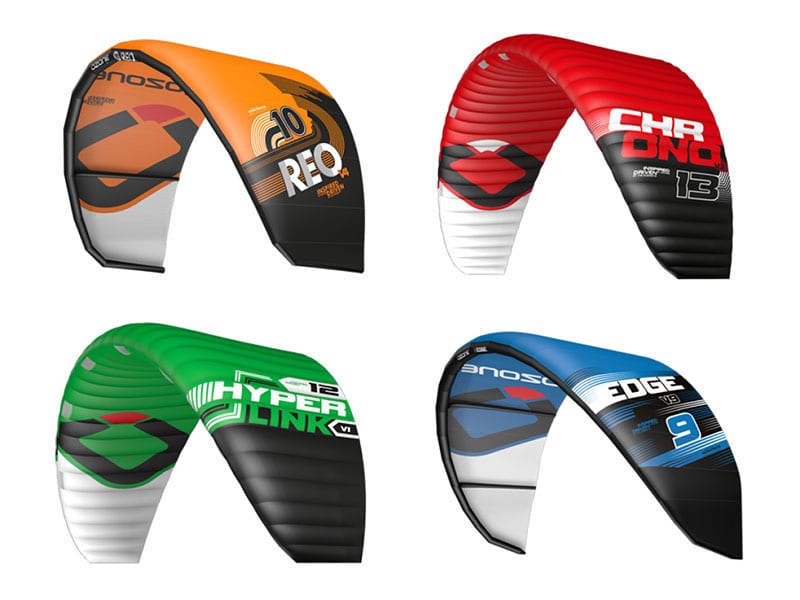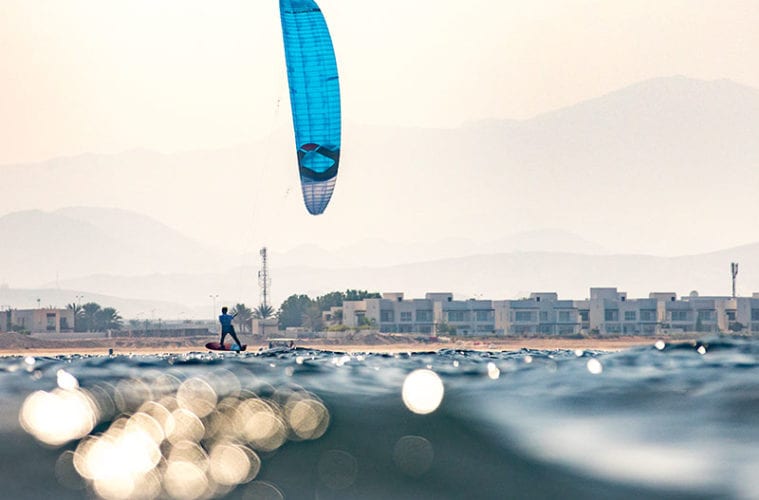When foiling, which kite to choose and which size to ride depends greatly on whether you are just learning or progressing into freeriding or racing. For your first session it is much easier to have a bit more power. You will want consistent wind that is sufficient to keep the kite in the air at all times and responsive. If you ride a twin tip you will choose a kite smaller than normal and if you ride a surfboard you would choose roughly the same size kite. The goal is to have the appropriate size of kite that allows you to park the kite while dealing with the board. If you rig too small you will have to fly the kite aggressively and this will take much needed attention away from mastering the basics of foilboard control. Some say the best wind is around 20 knots or so; generally bigger kites powered enough to sheet and go without too much steering are better than a twitchy fast-turning small kite. At the very least, you need enough power to relaunch if you drop your kite and the ability to get back to the beach with or without a board.
If you are using freeride or surf foil equipment with medium and lower aspect wings, once you have the basics of foiling and have learned how to pump the foil to propel you up to foiling speed you can use a much smaller kite size. The typical rule of thumb is two sizes smaller than usual, so if you would normally use a 12m with a surfboard, then you can use a 9m on your foilboard, or maybe even smaller depending on the size of your front wing and kite flying skills. However, it must be stressed that it is easier to learn maneuvers like tacks and jibes with sufficient power in the kite, so don’t go too small when trying to progress into new tricks and skills.
When it comes to foilboard racing the game is all about being able to fly the most powerful kite as possible while riding at maximum upwind and downwind angles around a race course. Racers are always pushing the boundaries of handling the biggest possible kite in the given wind conditions. To achieve this, racers use very short lines on high performance non-inflatable/foil kites. Even big kites (19m+) are flown on 12m lines nowadays. This naturally means a bigger kite, so if you would be out on a 9m kite with normal (23- 25m) lines on a twin tip, you would probably race with a 9m and 12-13m lines on a foil in the same wind.
 Choosing to use a foil kite or an inflatable kite is an interesting topic which has long been debated. Each design has its advantages and disadvantages, but generally, foil kites shine in really light winds under 10 knots and offer more power per square meter while still being easily relaunchable. Inflatable kites (including single and no strut) tend to become more difficult to launch if conditions are under 10 knots while a foil kite offers the advantage of a much lighter canopy that can easily be reverse launched. While foil kite inflation technology has improved significantly, inflatables are probably the better choice for a beginner foilboarder to have in a self-rescue situation.
Choosing to use a foil kite or an inflatable kite is an interesting topic which has long been debated. Each design has its advantages and disadvantages, but generally, foil kites shine in really light winds under 10 knots and offer more power per square meter while still being easily relaunchable. Inflatable kites (including single and no strut) tend to become more difficult to launch if conditions are under 10 knots while a foil kite offers the advantage of a much lighter canopy that can easily be reverse launched. While foil kite inflation technology has improved significantly, inflatables are probably the better choice for a beginner foilboarder to have in a self-rescue situation.
A typical rule of thumb is that a foil kite will have about the same power as one size up in an inflatable. For example, a 12m foil kite will pull as much as a 15m inflatable. In winds above 10 knots, it really comes down to preference””a small inflatable turns faster and can be worked and looped much easier and opens up a few more options for freeride style riding. Above all else, it makes the most sense to use a kite that you are familiar with when learning to foil. There is no point using a foil kite for the first time whilst learning to foilboard; you need to focus on the board and not on learning to use a new kite at the same time.
This article is featured in Tkb’s Foil Instructional Guide along with tons more tips and tricks to help speed up your foilboarding progression. Grab a digital copy here: https://www.thekiteboarder.com/product/tkb-foil-instructional-guide/



